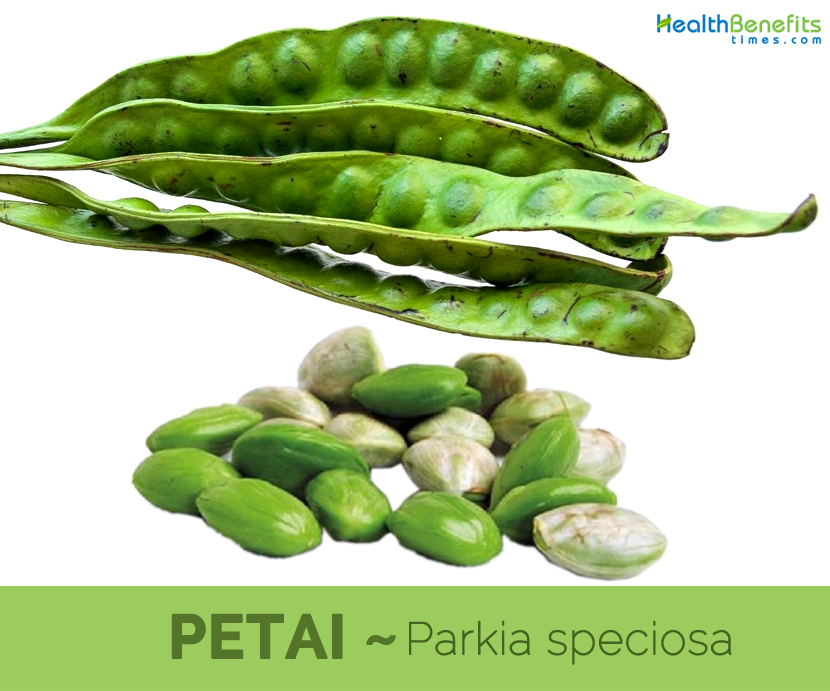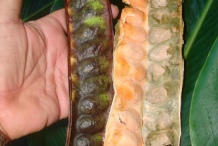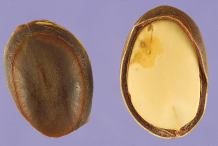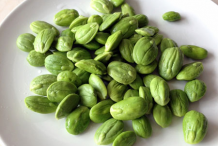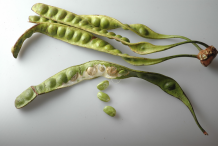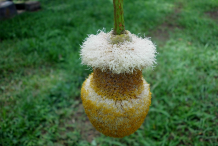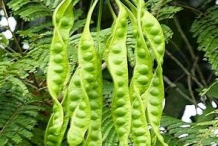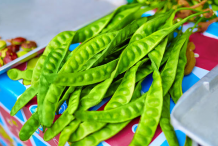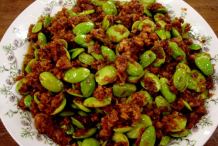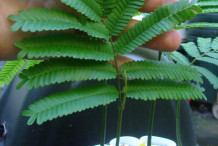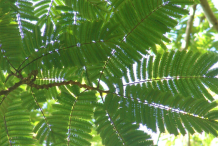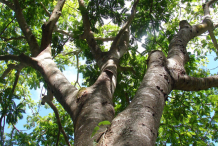Parkia speciosa is really a variety of the genus parkia in the family fabaceae which has numerous names, amongst others, petai, peteh, bean bitter, turned cluster bean, stink bean, sator, sataw, yongchaak and zawngah.
Plants parkia speciosa well-known in Southeast Asian countries just like Indonesia, Malaysia, Singapore, Thailand, and Laos exactly where parkia speciosa is long along with vibrant green beans inside. The shape is comparable along with almond shape. Petai is sold in several forms just like sold in bunches, in pods, seeds or even petai seeds are loaded in plastic bag, plus some even purchased in the type of pickles in water, or perhaps in the type of frozen.
| Petai Quick Facts | |
|---|---|
| Name: | Petai |
| Scientific Name: | Parkia speciosa |
| Origin | Malaysia, Brunei, Indonesia, peninsular Thailand and the Philippines |
| Colors | Green becoming black when they ripen (Pods) |
| Shapes | Large, 35–55 cm long and 3–5 cm wide, straight or more commonly twisted; hanging in small bundles of 6–10 (Pods) |
| Calories | 124 Kcal./cup |
| Major nutrients | Iron(42.50%) Vitamin C (36.33%) Protein (20.00%) Vitamin B2 (15.38%) Carbohydrate (13.00%) |
| Health benefits | Depression, PMS (premenstrual syndrome), Anemia, Blood Pressure, Brain Power, Constipation, Hangovers, Heartburn, Morning Sickness, Mosquito bites, Nerves, Overweight, Ulcers, Temperature control, Smoking, Stress, Strokes, Warts, Healthy eyes and improve concentration, Improving digestion, Ulcers, Hangovers, Seasonal Affective Disorder |
| Name | Petai |
|---|---|
| Scientific Name | Parkia speciosa |
| Native | Native to Malaysia, Brunei, Indonesia, peninsular Thailand and the Philippines (Palawan). Occasionally it is cultivated, but rarely outside its native area. |
| Common Names | Bitter Bean, Petai Bean, Stink Bean, Twisted Cluster Bean, sator bean, sataw, yongchaa, yongchaak, zawng ah |
| Name in Other Languages | Dutch: Stinkboon English: Petai bean, Twisted cluster bean, Stink bean India : Yongchak ( Manipur) Indonesia : Petai Papan, Pete, Sindutan ( Javanese) , Kundai, Patak ( Dyak, Tinggalan, Kalimantan), Petah ( Busang, Kenya, Kalimantan ), petai ( Katingan, Sampit, Kalimantan ), Nuep ( Kalimantan ), Petai, Pete ( Malay ), Petteh ( Madurese ), Petej , Petej Pare, Petej gede, Sigobang ( Sundanese ) Japanese: Nejire Fusamame, Nejire Fusa Mame No Ki Malay: Petai Malaysia : Chou Dou ( Cantonese ), Nyiring, Patag, Patai, Petah, Petai Philippines: u’pang (Palawan) Swedish: Petai Tagalog: Kupang Thai: Kato (กะตอ ), Pa ta (ปะตา ), Pa tai(ปาไต ), Pat to (ปัตเต๊าะ ), Sato (Satoo, Sator, Sataw), To dan, To kkhao Thailand : Nitta, Sator, Sator Dan, Sator Kow, To Dan, To Khao Philippines: U’pang ( Tagalog) |
| Plant Growth Habit | Erect and evergreen tree |
| Soil | Thrives best on well-drained loamy or clay-loam soils |
| Plant Size | About 30 m in height |
| Branchlets | Puberulous branchlets |
| Bark | Smooth reddish-brown bark |
| Stem | 50–100 cm diameter |
| Leaf | Alternate, bipinnate; petiole 2-6 cm long, with subcircular gland about 1 cm above the base; rachis 18-30 cm long, with subcircular glands between the junctions of the basal pairs of pinnae; pinnae 14-18 pairs, 3-9 cm long, with circular glands below the basal pairs of leaflets; |
| Leaflets | (18-)31-38 pairs per pinna, linear, 5-9 mm × 1.5-2.2 mm, base at one side expanded into an apiculate auricle, apex rounded, mucronate. |
| Flower | Pear-shaped pendulous head, 2-5 cm in diameter; peduncle 20-45 cm long; flowers small and numerous, brown-yellow, male or asexual at the base of the head, bisexual at the apex of the head; calyx and corolla tubular, 5-lobed; stamens (staminodes) 10, filaments at base united into a tube; ovary stipitate |
| Pods Shape & Size | Large, 35–55 cm long and 3–5 cm wide, straight or more commonly twisted; hanging in small bundles of 6–10 |
| Pods Color | Green becoming black when they ripen |
| Flavor/Aroma | Somewhat peculiar smell |
| Seed | 10–18 large, broadly ovoid, 2-2.5 cm × 1.5-2 cm, horizontal in the pod, testa very thin, white. |
| Major Nutrition | Iron, Fe 3.4 mg (42.50%) Vitamin C (Ascorbic acid) 32.7 mg (36.33%) Protein 10 g (20.00%) Vitamin B2 (Riboflavin) 0.2 mg (15.38%) Carbohydrate 16.9 g (13.00%) Calcium, Ca 126 mg (12.60%) Vitamin B1 (Thiamin) 0.15 mg (12.50%) Potassium, K 376 mg (8.00%) Total Fat (lipid) 1.8 g (5.14%) Vitamin B3 (Niacin) 0.5 mg (3.13%) Total dietary Fiber 1 g (2.63%) Sodium, Na 11 mg (0.73%) Phosphorus, P 3 mg (0.43%) |
| Calories in (100 gm) | 124 k cal |
| Health Benefits |
|
Health benefits of Petai
Petai fruit not just offer power, but in addition capable to avoid as well as defeat numerous health problems and conditions. In comparison apples, petai has got protein Four times more, carbohydrates over double the amount, 3 times the phosphorus, 5 times the vitamin A and also iron, and two times as many vitamins along with other minerals.
A number of the health improvements are highlighted below
1. Depression
In accordance with a current study carried out by MIND amongst individuals struggling with depressive disorders, numerous felt far better after consuming petai. It is because petai include tryptophan, a kind of protein which the body changes into serotonin, recognized to cause you to relax, enhance your mood and usually cause you to feel more comfortable.
2. PMS (premenstrual syndrome)
Ignore the pills – consume petai. The vitamin B6 it includes manages blood sugar levels, which could impact your mood.
3. Anemia
Loaded with iron, petai can easily encourage the creation of hemoglobin within the blood and thus assists in cases of anemia.
4. Blood Pressure
This excellent exotic bean is incredibly loaded with potassium but lower in salt, which makes it ideal to conquer blood pressure level. So much in fact, the US Food and Drug Administration have recently permitted the petai industry to create official claims for the fruit’s capability to prevent blood pressure level and also heart stroke.
5. Brain Power
Research has revealed that the potassium-packed fruit might help learning by causing students much more alert as well as increase memory.
6. Constipation
Loaded with fiber, which includes petai within the diet might help recover normal bowel action, assisting to conquer the issue without making use of laxatives.
7. Hangovers
One of many fastest methods for treating a hangover is usually to create a petai milkshake, sweetened along with honey. The petai calms the stomach as well as, with the aid of the honey, accumulates exhausted blood sugar levels, whilst the milk calms as well as re-hydrates your whole body.
8. Heartburn
Petai features a all-natural antacid effect within the body, so when you have problems with heartburn, try to consume petai for calming relief.
9. Morning Sickness
Eating petai in between meals keeps blood glucose levels up and prevent morning sickness in females.
10. Mosquito bites
Just before reaching for the insect bite cream, try out massaging the affected region using the interior of the petai skin. Many individuals think it is surprisingly effective at decreasing swelling as well as discomfort.
11. Nerves
Petai has elevated levels of B vitamins which help relaxed the central nervous system.
12. Overweight
Studies in the Institute of Psychology in Austria discovered pressure at the job results in gorging on comfort food just like chocolate and crisps. Checking out 5,000 hospital people, scientists discovered the most overweight were more prone to be in high-pressure jobs. The report determined that, to prevent panic-induced craving for food, we have to manage our blood glucose levels by eating high carbohydrate foods each 2 hours to maintain levels constant.
13. Ulcers
Petai is utilized as the dietary food towards intestinal disorders due to the soft texture as well as smoothness. It’s the only raw fruit that may be consumed without distress in long-term cases. Additionally, it neutralizes level of acidity and decreases irritation by coating the lining of the stomach.
14. Temperature control
A number of other cultures observe petai like a “cooling” bean that may reduce both emotional and physical temperature of pregnant women. In Holland, as an example, expectant women consume petai to make sure their baby is born having a cool temperature.
15. Smoking
Petai may also help individuals attempting to quit smoking. The B6, B12 they include, along with the potassium and magnesium present in them, assist the body get over the end results of nicotine withdrawal.
16. Stress
Potassium is an important mineral, which will help stabilize the heart beat, sends oxygen towards the brain and also manages the human body’s water balance. When we’re anxious, our metabolic rate increases, therefore decreasing our potassium levels. These may be re balanced with the aid of a high-potassium petai snack.
17. Strokes
According to research through the New England Journal of Medicine discovered that every day practice of consuming petai capable to prevent death from strokes by 40%.
18. Warts
All those interested in all-natural alternatives swear that when you need to destroy a wart, have a little bit of petai and put it on the wart. Very carefully support the petai in position using a plaster or even surgical tape!
19. Healthy eyes and improve concentration
Petai include vitamin A quite higher at 200 IU per 100 mg. As is recognized, vitamin A very therapeutic for sustaining healthy corneas. Potassium within the banana can also improve concentration and also the ability of the brain so great to help those who have trouble to learn.
20. Improving digestion
Fiber is additionally found in numerous petai. Fiber or even fibers handy help digestion of food. For anybody who frequently has digestive problems just like constipation, consuming petai may help reduce your suffering. Petai in addition have a natural antacid effect within the body. If you feel nausea and fullness from consuming too much, petai can help to eliminate the pain sensation.
21. Ulcers
This particular fruit can reduce the effects of acidity and also decreases irritation by coating the lining of the stomach.
22. Hangovers
Petai is combined with honey and milk, this particular milkshakes made is considered to help to ease hangover gone through by an individual due to this herb can easily enhance blood glucose levels whilst the milk is wonderful for calming as well as re-fix the fluid level within the body.
23. Seasonal Affective Disorder (SAD)
(a chaotic emotional illness). In case you evaluate it along with apples, Parkia speciosa has got four times much more protein, two times the carbohydrate, 3 times the phosphorus, 5 times the vitamin A as well as iron, and two times the other minerals and vitamins. Parkia speciosa is additionally abundant with potassium. Therefore like when the Parkia speciosa nicknamed “A Parkia speciosa per day keeps the doctor away”.
More about Petai
To be consumed then parkia speciosa or even petai needs to be peeled first, and after peeled, petai or even parkia speciosa seeds normally can be ingested directly, boiled, or even baked, and petai seed is additionally broadly ingested by combined with various other foods just like combined with , chili, garlic, dried shrimp, fish, duck, vegetables, and so on.
Petai features a sharp odor mainly because it consists of certain amino acids, and for that reason earned the nickname petai beans and also the smell within the mouth and body and in addition supplies a strong odor of urine that may give effect to 2 days after consuming petai, and also this complex carbohydrate within the parkia speciosa may cause a sharp-smelling fart too.
History of Petai
The nationality of Petai can be extremely hard to figure out in cases that regional limitations alter as time passes, leaving behind the initial nationality a mysterious. The initial ethnicity of Petai might be hard to figure out as a consequence of whether the title came about naturally as well as individually in a variety of locales; e.g. in the matter of family names which come from professions, which could come in several locations individually (like the last name “Fisher” which has been provided to fishermen).
Traditional Medicinal benefits
- In southeast Asia, the seeds are used traditionally for the treatment of diabetes, scabies, oedema, high blood pressure, inflammation of kidneys, cancer, hepatalgia, nephritis, colic, cholera and as an anthelmintic to expel worms.
- Seeds are also applied externally to wounds.
- Seeds are valued as a carminative.
- Leaves are used against jaundice.
Culinary Uses
- Part of the sprouts and of the thickened inflorescence stalks, young feathery leaves, young fruit pods and seeds are eaten raw or roasted and cooked as vegetable as well.
- Seeds are eaten raw, blanched and sometimes mix with ingredients like dried shrimps, garlic, chilli and belacan in a dish called sambal petai or used in stir-fries, salad, soup, curry (e.g. Thai green duck curry) and in other hot spicy dishes.
- They taste good in a sweet and sour stir-fry.
- In North-eastern India, the seeds or the bean as a whole are eaten in a local delicacy call Iromba (dish made from fermented fish) or Yongchak singju (type of vegetable salad).
- In Thailand, the seeds are sometimes roasted and eaten with Nam Prik (a type of spicy paste), they are also fried with curry paste mixed with shrimp or pork or are made into pickles.
- Seeds are also dried and seasoned for later consumption.
- Young flat fruit pods with undeveloped seeds can be eaten raw, fried or pickled.
- Half-ripe pods are usually pickled in salt.
- Young leaves and the pear-shaped receptacle of the inflorescence can also be consumed raw as lalab, but they are not used to a great extent.
Recipe Of “Sambal Petai”
Here a tangy gastronomic that we would like to share with you…we bet you are eager enough to know what ingredient it needs to make this lip smacking good dish…
- 12 prawn, cleaned and peeled
- 150g dried shrimp, soaked and minced
- 8 fresh chilies, crushed.
- 5 cloves garlic, crushed
- 200g petai bean
- salt to taste
- 4 red shallots, crushed.
- 1 tbsp sugar
- 1 tbsp lime juice
- cooking oil
Ok, five minutes, just five minutes, with these simple steps shown below you can make this great dish at home with just five minutes…
- Heat up a pan or wok with oil, and fry the crushed garlic and red shallots till fragrant.
- Add in the crushed chilies and minced dried shrimp, stir fry till fragrant.
- Put in the petai bean and prawns, stir fry for 2 minutes or till prawns are fully cooked.
- Add in sugar and enough salt, stir fry till mixed well.
- Off the fire, add in lime juice, served with steamed rice.
Other Facts
- Wood is used in the manufacture of paper.
- Tree yields a usually lightweight, occasionally medium-weight hardwood which is used in the manufacture of cabinet work and boxes.
- It is sometimes planted as a shade tree, for example, for coffee plantations and in nurseries.
- The flowers secrete nectar that attracts bats and other pollinators.
Precautions
- Petai beans contain djenkolic acid, a sulphur-containing amino acid that is mildly toxic.
- In high concentration, it causes “spasmodic pain, gout, urinary obstruction and acute renal failure”.
- It may contain moderate to high levels of purine, hence people who are susceptible to gout should consume petai in moderation.
- Petai has an anti-bacterial and anti-inflammatory effect on the kidney, consumption of petai may need to be limited for patients with kidney disease.
Petai Facts
Parkia speciosa commonly known as Petai is actually a erect and evergreen tree native to Malaysia, Brunei, Indonesia, peninsular Thailand and the Philippines (Palawan). Occasionally it is cultivated, but rarely outside its native area. The tree bears long, flat edible beans with bright green seeds the size and shape of plump almonds which have a rather peculiar smell, similar to that of the Shiitake mushroom. It has been used in folk medicine to treat hypertension, diabetes, and kidney problems. They are best when consumed with other strongly flavored foods such as garlic, chili peppers, dried shrimp or shrimp paste.
References:
https://www.itis.gov/servlet/SingleRpt/SingleRpt?search_topic=TSN&search_value=506261#null
http://www.plantnames.unimelb.edu.au/Sorting/Parkia.html
http://www.hear.org/pier/species/parkia_speciosa.htm
http://www.theplantlist.org/tpl1.1/record/ild-46350
http://uses.plantnet-project.org/en/Parkia_speciosa_(PROSEA)
https://plants.usda.gov/core/profile?symbol=PASP15
https://en.wikipedia.org/wiki/Parkia_speciosa


